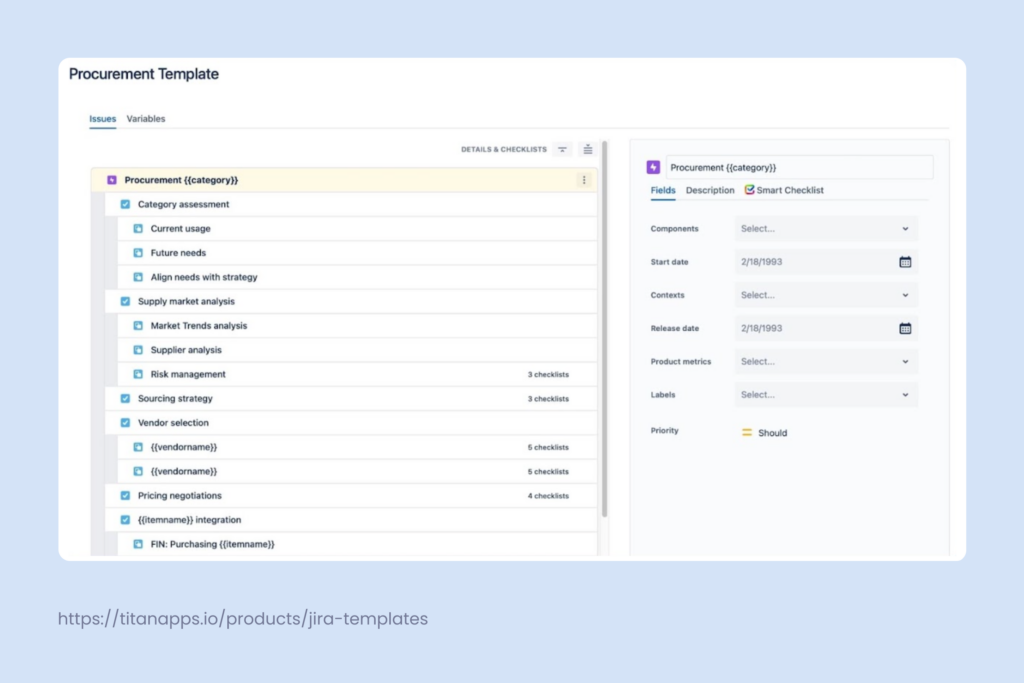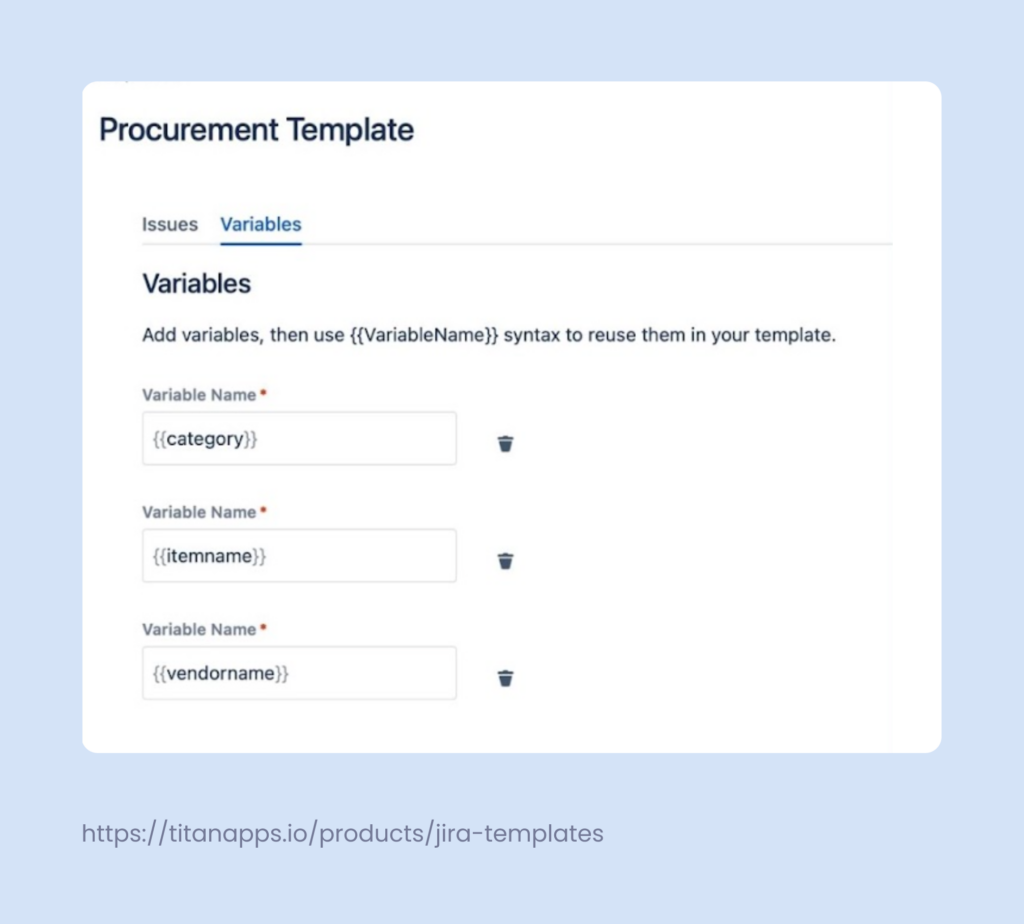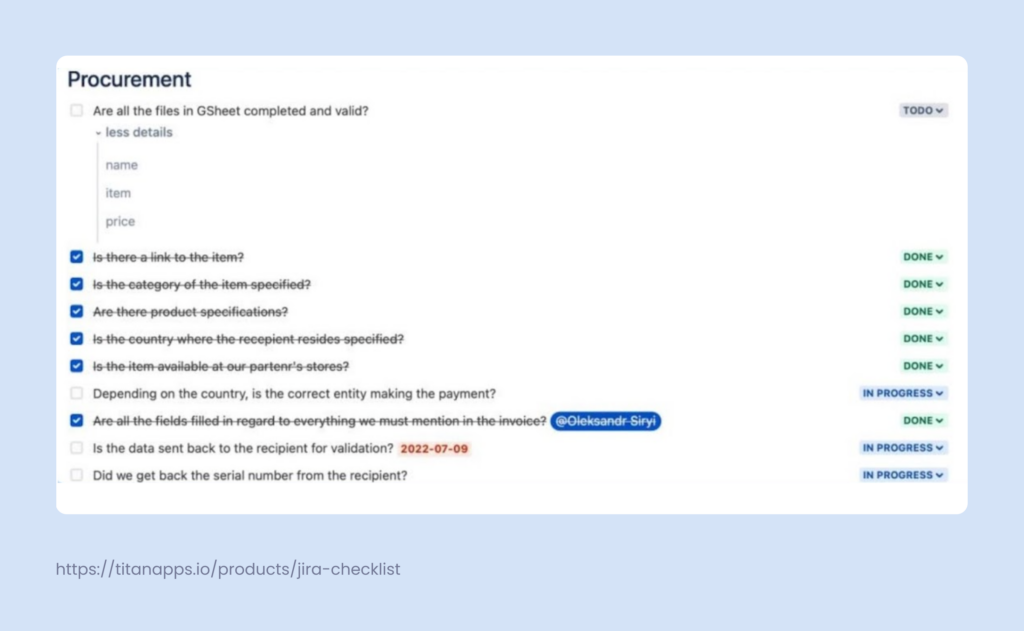Procurement is a complex and nuanced process that involves attention to detail in multiple stages. Recreating this process in Jira every time you need to order a new laptop for an employee or a new software service for the marketing team is tedious and time-consuming.
Sure, Jira offers several workarounds like issue cloning, but most of them are clunky and require a lot of effort to set up and maintain.
This article shows a simpler, more intuitive way of crafting a reliable and reusable procurement template in Jira. For the magic to work, you’ll need one or two external Jira apps. Both of them have a free trial. Give them a shot and see if the process works for you.
Note: Explore all of the options for creating templates in Jira here
What goes into a Procurement Template in Jira?
Generally speaking, a procurement template should include several Jira issues with specific instructions and checklists. These can serve as tasks for your team to:
- Identify the exact need for hardware or software;
- Find the suppliers and request the bids or send an RFX (Request for Proposal, Request for Quotation, Request for Information, etc.);
- Draw up a contract with the vendor;
- Set up a payment process;
- Manage and support the delivery of the product;
- Perform the Execution & Integration activities, monitor results, and evaluate the vendor, ensuring the company is getting the best product or service per price and conditions.
Each of these tasks is then broken down into smaller subtasks. For example, the sourcing process includes subtasks such as:
- Identifying a list of vendors
- Narrowing this down to approved vendors
- Identifying which factors impact the price
- Identifying an acceptable rationale for not simply going with the lowest bid and calling it a day
- Negotiating a better deal as well as the terms (buying in bulk)
- Considering factors such as service warranty, etc.
As you can see, going through each and every detail of the process by hand every time the team needs something will become a nightmare.
That said, skipping the documentation stage and going with a simple Jira task will inevitably lead to missing one or several stages of the process. You need a template.
Think about it: having the documentation and history of purchases in one place quickly becomes a single source of truth. In simpler words, you will get a crystal clear definition of a good deal in every category, like hardware or software.
This will help managers take ownership of what they buy and why, leading to cost savings and providing the business with the best products.
All things considered, biting the bullet and taking the time to set everything up once is probably the best option.
How to create a Procurement Template in Jira with Smart Templates?
Given the amount of detail that goes into each stage of the procurement process, it’s probably best that you document all of them inside Jira issues. The seven steps of strategic sourcing can be used as a guide for creating a meaningful and context-rich list of Jira tasks.
- Category assessment tasks: Are you procuring software, hardware, or services? Specify these categories with labels in your issues. Also, add some sub-tasks for:
- Accessing current usage
- Accessing future needs
- Aligning the usage and needs with the current business strategy
- Supply market analysis tasks: These tasks are generally focused on understanding the supply dynamics. They should help you better understand availability, pricing, and innovation on the market. Create sub-tasks for:
- Market trends analysis
- Supplier analysis
- Risk management
- Strategy development: This stage is mostly analytical. The goal is to ensure that you are getting the best value for your investment. This task doesn’t require subtasks, but you can add a checklist of things you need to keep an eye on:
- Should you form a partnership?
- Should you pursue competitive bidding?
- Should you consider bulk pricing?
- Vendor selection: Having a short list of vendors means that the negotiations are about to start. You can use separate subtasks for vendors, each with a separate checklist for evaluation. Guessing the exact number of vendors you’ll be reviewing is hard, so I suggest creating one subtask for the purposes of a template. Hint: You can save and reuse it as a separate template.
- Vendor negotiations: This is one parent task that needs a good checklist for clearly identifying aspects such as:
- Pricing
- Delivery schedules
- Support
- Potential contractual terms
- Execution and integration: This stage involves two primary subtasks: placing the order and integrating the product. The latter part might involve separate subtasks for members of other teams, like IT or security if they need to check, validate, or set up the purchase. You can also have a separate subtask for the finance team to make and record the purchase.
- Benchmarks and results monitoring: The last step of the sourcing process revolves around monitoring the vendor’s performance and comparing it to certain benchmarks like industry standards or your previous experiences. This step can be described in one task. Make sure to use a checklist so that the procurement specialist doesn’t forget to check crucial information like compliance with contractual terms.
This template is designed to be universal. You can use it as inspiration for crafting your process, or you can break it down into separate templates for various teams. For instance, the sourcing team will benefit from steps 1-5. The management and procurement might benefit from steps 5-7. Other departments like IT or finance can use a template of tasks from step 6.
How do you translate all of these tasks into Jira?
For starters, I’d suggest setting up an Epic to serve as a parent to all of the tasks. This way, you’ll have the added flexibility of using both tasks and sub-tasks for a more granular distribution of work. Sure, setting up the descriptions, labels, checklists, and assignees will take some time but hey, you only need to do the hard part once. You can then save and reuse the whole hierarchy of issues any time you need to source something.
Alternatively, Smart Templates allows you to set up all of the tasks, subtasks, and even checklists from within one intuitive interface. Let’s give it a go, shall we?
Step 1: Download the Smart Templates app from the Atlassian Marketplace
Smart Templates is a lightweight and intuitive app, so none of the steps below are rocket science. Still, this one is probably the easiest.
Simply find the Smart Templates app on the Atlassian Marketplace and install it.
Note: You’ll need Jira admin permissions to install apps from the marketplace.
Step 2: Open the app and create your template
Creating a procurement template with Smart Templates is rather straightforward.
- Open the app from the left sidebar in Jira
- Click on the Create a Template button
- Add your tasks, subtasks, and field values like components, due dates, assignees, etc.
A list of issues on the right gives you a brief overview. You can add your tasks and subtasks here.
Clicking on the subtask will show you the options for editing the issue fields on the left.
Once you are done filling up the tasks for the procurement process, you’ll end up with a template that looks something like this:

Check more details about the editing options in our Knowledge Base.
Step 3: Add text variables
Technically, you have a nice procurement template after step two. Still, you can enhance it with Tex Variables. This feature prompts a user to enter specific data (like the item’s name, category, or the name of the vendor) every time the template is applied.
- Select the variables tab above the list of issues.
- Add a new variable. Let’s say this will be the name of the item we need to purchase.
- Copy the variable’s name, go to the Issues Tab, and paste it into the summary field of any tasks that could benefit from having the item’s name. Make sure that the variable is surrounded by two sets of rounded brackets like so {{ItemName}}
- Click the Save button.

Step 4: Add checklists to your tasks
While this step is optional, I highly recommend complementing your newly created template with checklists. The procurement process is simply too complex and granular for anybody to keep in their head.
Having a checklist inside the issues will offer the procurement team more peace of mind, as every task will include detailed instructions and clear ToDos.
The beauty of this checklist lies in its simplicity. The entire workflow is clear for people who are still new to the procurement team. It is beneficial to have expandable info where newbies can learn more. This approach also works for everyone looking for information that is rarely used; hence, no one keeps it in their cortex. For example, you can explain what every GSheet field is used for or how to properly link the items to the corporate inventory.
The individual items of the checklist become actionable items where you can tag people you need to connect with, set up a deadline for a process, or convert a point into a new Jira ticket.

Summary
As you can see, creating a reusable yet detail-rich procurement template doesn’t take longer than 15-20 minutes when you come equipped with the right tools. Doesn’t seem like a huge time investment, given you:
- Have every step of the procurement process documented
- The entire process is available to the whole team, no knowledge is gated
- The process stays with you forever
- It can be easily changed or modified to better meet your needs at any given point in time


